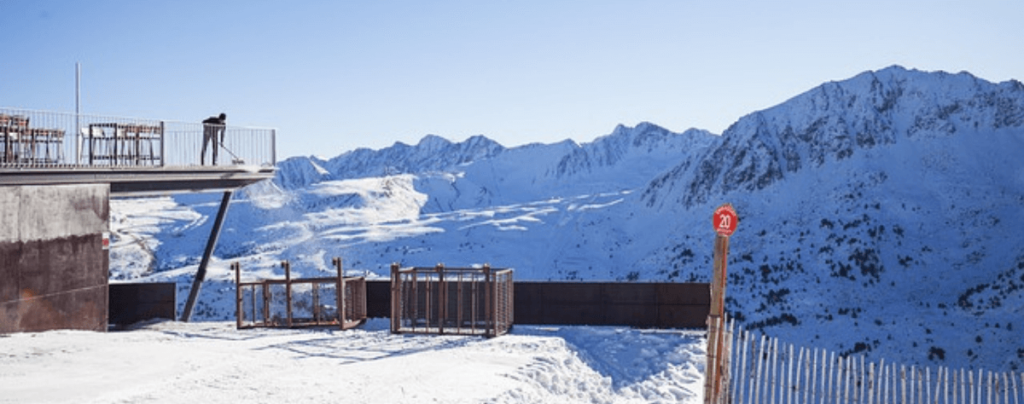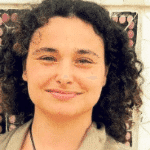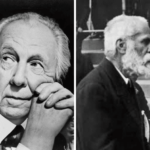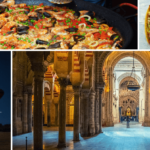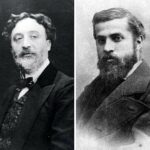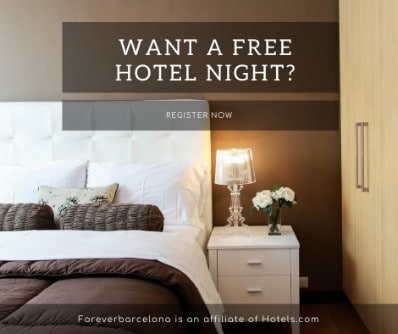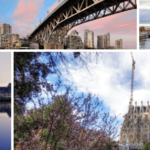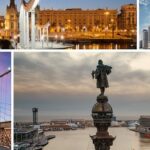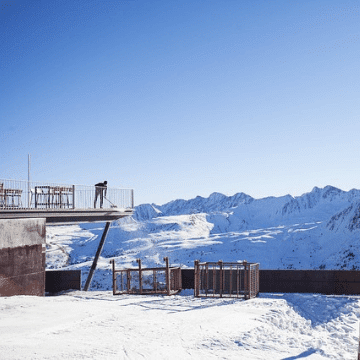
Between Spain and France: Andorra Facts and Information
GET TO KNOW THE COUNTRY OF THE PYRENEES
If there’s been a Covid travel trend, that has been fleeing the cities and heading to the mountains. In over 20 years of giving tours I had only taken one group to Andorra and had very rarely received inquiries about day trips there. But this last year I’ve been contacted about it enough times for me to decide to create a specific Andorra tour.
If you’ve never heard of this place before, let me sum it up for you. Andorra is a tiny independent country up in the Pyrenees mountains, between France and Spain.
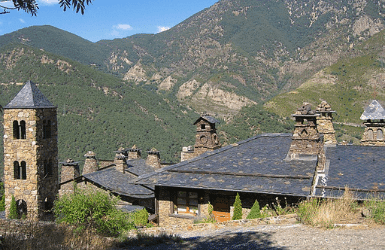
And there's lots of interesting things worth knowing about it. This is what today's post is about! But it makes for some longish reading... Will you stay with us?
Or if you are in a hurry, let me give you first a...
Quick summary of Andorra interesting facts
- The official language of Andorra is Catalan.
- The flag of Andorra looks like the ones of Moldavia, Txad and Romania, except for the Andorran coats of arms in the middle.
- Andorra uses the Euro as currency, even if it’s not part of the EU.
- Banking, tax-free shopping, tourism and tobacco are the most important sources of economy in Andorra.
- Andorra has only two official Customs points: one in the border with Spain and the other in the French border.
- It’s way easier to reach Andorra by public transportation from Spain than from France.
- Andorra has a population of 77.265 inhabitants but only 49% of them hold an Andorran passport.
- Andorra is an independent country, but the Bishop of Urgell and the President of France are its co-princes.
- Andorra is the 6th smallest country in Europe.
- Two Catalan villages are easier to reach via Andorra than through Spanish roads.
Basic facts about Andorra
1
Where is Andorra on a map of Europe?
The 5 smallest are Vatican City, Monaco, San Marino, Liechtenstein and Malta. The 7th smallest country, Luxemburg, is 5 times bigger and it’s not considered a micro-country.
There’s only two official Customs points to enter the country: the Spanish entry via Sant Julià de Loira (CG-1 road), and the French access via Pas de la Casa (CG-2). Both points are connected via the capital city, Andorra la Vella, and it takes rough 1 hour to cross the country.
Interestingly enough, there’s two more roads connecting Andorra and Spain: The CG-4 takes you to the Catalan village of Tor and the wild life refugee of the Cova d’en Josep Montaner. While they can also be accessed via a very bad secondary mountain road from the Vallferrera Valley in Spain, Andorra remains the easiest way to get there.
The same happens with the Catalan village of Os de Civís, easily accessible via the GG-6, but harder to get to through the Spanish local road departing from La Farga de Moles. Besides these roads, there’s of course many cross-border trails that have traditionally been used by shepherds, smugglers and nowadays, hikers.
2
Why is Andorra a country?
And by 817 Andorra became officially part of the Carolingean Empire – that is, the ancestors of the French. Little after, in 843, they were transferred to the County of Urgell. And in 1133 the Count of Urgell transferred the Andorra valleys to the Bishopric of Urgell, still officially under the Carolingian/Franc power but not for long.
In 1137, the marriage of Count Ramon Berenger IV of Barcelona and the princess Peronella of Aragon marks the independence of the Catalan counties (including that of Urgell) from the ancestors of the French.
But eventually the Bishop of Urgell will transfer part of its power over Andorra to the feudal lords of the Caboet family. And those in 1208 joined the County of Foix (France) by marriage.
This unusual juridical situation led to the writing of the “pareatges“, documents setting up the limits of the power of the French lords and the Catalan Bishops over the Andorran families, and the obligations the Andorra would have towards them. And in 1419 the Andorrans were allowed to create the Consell the la Terra, a council to defend their interests, that would become the seed of their parliament.
In 1589, Enric II of Foix became King Henry IV of France, but that didn’t alter the way Andorra was ruled. And in the next centuries the Valleys maintained their neutrality in front of the conflicts between France and Spain.
When in 1793 King Louis XVI of France was decapitated during the French Revolution, the Republique decided to break their ties with Andorra and give them freedom. But that put Andorrans in a delicate political situation, since they still partly depended on the Bishop of Urgell. So in order to regain a balance of power, they pleaded Napoleon to take them back under his protection.
Being back to being ruled by both Spanish and French powers wasn’t easy. Both Spain and France would regularly try to increase their power over Andorra, although they never tried to militarily occupy the land. The final solution wouldn’t come until 1993, when a new Constitution was voted making Andorra a fully independent country.
3
Andorra Government
So who rules Andorra?
The legislative organ is the Consell General d’Andorra (heir of the medieval Consell de la Terra). It’s made of 28 counselors representing all 7 “parroquies” (translated as “parishes”, but used here as ·district”). They meet at the Casa de la Vall, in Andorra la Vella, and are elected every 4 years.
The executive organ is the Govern d’Andorra, presided by a Cap de Govern (head of the Government) chosen by the Consell General. The Cap de Govern can only hold the title for a maximum of 2 consecutive mandates.
Territory organization
Andorra is divided in 7 parishes: Canillo, Encamp, Ordino, la Massana, Andorra la Vella, Sant Julia de Loira and Escaldes-Engordany. They are divided in quarts or veïnats, neighborhoods.
The parishes are managed by a “comú” (town council) made of several consellers comunals (concilors). The equivalent to the major is the Consol major, and there is also a Consol menor.
4
Andorra Population
Interestingly, the law made so hard to get the Andorra nationality that until 2004 there were more Spanish nationals in Andorra than Andorrans. That changed when the law has made more flexible (even if still quite restrictive) in 2005.
The most populated town is Andorra la Vella, with 19.383 inhabitants, followed by the 14.599 of Escaldes-Engordany. Actually these two towns are nowadays just separated by one street: Carrer de la Unió. As you cross the street, you walk from one town to the other.
The next most populated towns have roughly thalf the population of Escaldes (around 7.500): Sant Julià de Loria and Encamp. And there’s 9 more villages with over 1.000 people.
5
How to get to Andorra
How to reach Andorra from Spain
It’s maybe 15 minutes faster… but you have to pay the Tunel del Cadi toll. And if you don’t want to drive, you can also take one of the many day trips to Andorra from Barcelona that allow you to visit the country in one day.
Andorra doesn’t have a railway system. If you want to take the train from Barcelona to Puigcerdà, then take a bus to Andorra. The train is slow (a 3-hour ride!), famous for not being punctual, and the carriages are old.
Andorra doesn’t have an airport, but the Catalan town of La Seu d’Urgell near the border has a small one with regular flights connecting with Madrid.
How to reach Andorra from France
The road from the Andorran-French border soon splits in two. One is a scenic road taking you to Bourg-Madame (the French side of Puigcerda) and from there continues to Perpignan. From there you can head back South to the Spanish border of La Jonquera, or North towards Narbone and Montpellier. The other road heads to Foix, from where you can head to Carcassone, Toulouse or West towards Pau and Bayonne.
You’ll need 1 or 2 connections to make it, and the total ride will be 7 to 11 hours. But once you get there, you’ll most likely need to take a taxi to Andorra: I wasn’t able to find bus lines connecting with Pas de la Casa or Andorra la Vella… The alternative via Puigcerda, then bus, won’t save you much time either.
The closest French airports are Les Pujols, Perpignan-Rivesaltes and Toulouse. But as I said, once there driving is the best way to go, since the public transportation options are a nightmare. However… if budget is not an issue you can book a taxi helicopter flight to the Andorra la Vella Heliport from Toulouse Airport.
Economical Facts of Andorra
6
Andorra GDP per capita
The GDP per capita of Andorra is 40.897,33 USD / € 35.996,31. That is slightly higher than France, but about 1/3 more than Spain. There is no records of poverty in Andorra, but with an unemployment rate of an average 3.6% we can infer that it is almost non-existent.
However, it is important to take into account that the Andorran Government is very protective of their nationals, and can easily deny work permits or renewals to qualified foreigners to benefit Andorra passport holders when deemed necessary.
7
Why is Andorra so rich?
BANKING
Bank secrecy was for many years a big economical source for Andorra. Andorra was a tax haven just like Switzerland, where often Spaniards and French would keep their money to avoid taxes in their countries (and hide their dirty money, too).
But in 2009 the President of France Nicolas Sarkozy threatened Andorra with dropping the co-princedom of Andorra if the country didn’t change their banking system. Then in 2015 one of the largest banks of Andorra, BPA, crashed due to several corruption scandals.
In 2016 the Consell General approved the end of bank secrecy and started signing data sharing agreements with other countries, and by 2018 the process was already automated.
TAX FREE SHOPPING
Despite the lack of industrial facilities in the mountains and the difficulties of importing products into the country because of their meager transportation network, the fact that for many years products didn’t pay VAT made Andorra a shopping destination.
Luxury products such as jewels, leather, brand clothing, perfumes, liquors and tobacco products were remarkably cheaper than in Spain and France. And so were food products such as chocolates, cheese and even salt.
In 2012 was however introduced the Impost General Directe (IGI), the equivalent to VAT, and prices rise but not that much: it is currently a 4.5% for most products and only a 1% for food and culture. What means shopping in Andorra continues to be a deal compared to France or Spain where VAT is around 20-21%.
TOURISM
Being located up in the Pyrenees mountains between 840m / 2755 ft and 2.942 m / 9652 ft over the level of the sea, Andorra is a clear mountain tourism destination.Their busiest time is the ski season in the winter. The coutnry features 3 ski resorts (Grandvalira, Ordino Arcadlís and Vallnord-Pal-Arinsal, with a total of over 300 km / 186 miles of slopes.
But now that climate change is reducing the amount of snow in the mountains, Andorra is now looking to attract mountain lovers all year around, with the maintenance of nicely kept hiking trails for all levels, a good network of guarded and unguarded shelters as well as mountain bike itineraries.
Another important focus is becoming a family destination, with family-friendly activities going from sport parks, to beautiful playgrounds, to easy hikes themed around fantastic characters from Andorran fairy tales. Finally, opening of the Caldea Spa in 1994 has become another great excuse to visit the country.
TOBACCO
So the tobacco farming continued to grow in Andorra, even more as the Industrial Revolution took over Europe and Andorra wasn’t able to catch up since its economy was mostly based in farming and cattle ranching. Therefore, tobacco farming was encouraged as a source of income.
The increase of the demand during the Spanish Civil War in the late 1930’s and World War II in the early 1940’s allowed the local farmers to modernize their production and open factories. And despite the competition of American and other foreign brands, the Andorran tobacco industry continued to be very profitable until the 1990’s.
After that, the added taxes, the fight against smuggling, and specially the anti-tobacco laws that have led to people smoking way less, the tobacco industry is facing challenges.
True: it’s still 35% of the country revenue, and 7% of the farmed land. But Andorrans know that alternatives are needed. Vineyards, wild berries and organic farming can be an option. But so far nothing brings farmers more money than tobacco.
8
Andorra currency
Andorra doesn’t have its own currency. Before the creation of the euro coin, in Andorra you could choose to use Spanish pesetas or French francs to pay for your purchases.
In 2002 all the currencies of the European Union were merged into the Euro coin. And while Andorra isn’t an EU member, they adopted it as their currency de facto. , and even in 2014 they issued their own euro coin models.
Andorra Culture Facts
9
Andorra Flag
10
Official Language of Andorra
Catalan is the official language of Andorra, and interestingly the only country in the world where this language is the first official language. For instance, in Spain it’s only official in certain regions such as Catalonia, but always together with Spanish.
However, the large number of immigrants living in Andorra makes that only 38.8% of its inhabitants have Catalan as their mother tongue (although 58.3% consider it their main language). Spanish follows with 35.4% having it as their mother tongue and a similar number as their main language.
Portuguese is the mother tongue of 15% of the population, but only 3.5% use it on their daily activities. And French is the mother tongue of 5.4% , but less than half of them use it as their main language. Other languages are marginal.
What are your favorite facts about Andorra?
Marta
MORE BARCELONA TIPS FOR YOU:
SHARE WITH YOUR TRAVEL MATES
RESEARCHING FOR A TRIP IS TIME-CONSUMING…
Need more inspiration?
Our 100% FREE Barcelona Collection will give you everything you need to organize the trip of your lifetime to Barcelona.
BEST INSIDER TIPS FROM THE PROS!
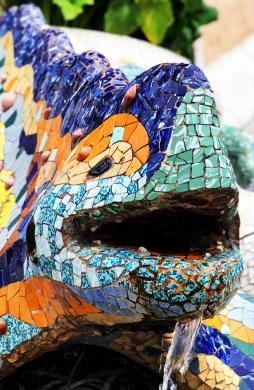
Last update on 2024-04-24 / Affiliate links / Images from Amazon Product Advertising API

